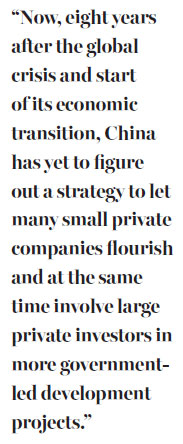High house prices only a symptom

Private investors opt for the familiar when they can't find better options, showing need to encourage better use for that money
Twists and turns abound. But one thing has remained fairly consistent in China - that when private investment is on the low ebb, a phenomenal amount of money stays in the real estate market in the major cities.
This was the situation in the first couple of years in the post-crisis era, in 2009-10. There seems a sense of deja vu this summer.
In Beijing, in the last week of July, of all new and second hand home units, sales growth was most marked in the units tied to fewer restrictions for nonresident buyers and presumably easier to be resold.

In Shanghai, sales and per unit price of sales grew in July, particularly strongly in the high-end sector of the market, or units priced from 100,000 yuan ($15,070; 13,500 euros) per square meter.
Both cases seem to indicate a large contribution from people who don't necessarily have residential status in either city. In other words, many buyers don't want to just move into the new units they've bought. Their main purpose is to park their idle money in the assets, which may generate a rate of return before they can find more profitable investment opportunities.
This is a common strategy that many wealthy people use. It may appear a rather conservative way to manage a family's resources when people can choose among the securities markets and direct investment ventures at home and overseas.
But in a time of uncertainties, such as poor protection of rights and murky prospects for returns, it is always knowledge about a local market, and interests that one can touch and feel, that prevail. That said, large cities' housing markets may serve as a barometer for the Chinese economy. Housing sales and price increases in Beijing and Shanghai become unstoppable whenever the progress in reform is slow and channels for private investment are clogged or damaged.
Ever since the 2008 global crisis, China has never been quite successful in channeling domestic investment to the most useful purposes. The reason is simple: Many of the old channels are no longer profitable, such as investments in simple processing and manufacturing.
That is also why in the industries traditionally dominated by state-owned enterprises, only a few privately owned enterprises can eventually grow into worthy competitors. Small private investors, due to local governments' constant change of urban plans and subsequent relocation programs, have a hard time growing large.

Now, eight years after the global crisis and start of its economic transition, China has yet to figure out a strategy to let many small private companies flourish and at the same time involve large private investors in more government-led development projects. The idea about public-private partnership has, up to now, remained an idea.
One example is Shenzhen, industry wise the country's most innovative city. It is also one of three cities, the other two being Beijing and Shanghai, leading the rise in housing prices in China.
In urban administration, Shenzhen seems no different from many other cities in the Chinese mainland and has many holes in its system.
In a follow-up report about the destruction caused by a recent typhoon, Hong Kong-based Ta Kung Pao reported that the newly developed city will have to build as much as 1,000 kilometers of underground drainage system, which would take up to 30 billion yuan in investment.
But up to now, two-thirds of the city's underground tunnels have shown problems with engineering quality, because they were built during a time of poor supervision of contractors in the 1980s and '90s, when local officials and their contractor friends were able to collaborate in massive misuse of public funds.
But why can't the city adopt new and more lawful ways to involve private capital in public utility programs? It is either because local bureaucrats refuse to learn or because there are still higher institutional barriers that are difficult for them to overcome by themselves.
Anyway, this kind of contrast seems universal in the country. On one hand, there is a large pool of private capital waiting for opportunities with good returns. On the other hand, there are many public systems that remain inadequately funded, with frequent road congestion and downtown flooding being their only by-products.
How can China put its own people's resources to better use? This is an ultimate question it has to answer in its reforms.
The author is an editor-at-large of China Daily. Contact the writer at edzhang@chinadaily.com.cn
(China Daily European Weekly 08/05/2016 page13)
Today's Top News
- Xi stresses improving long-term mechanisms for cyberspace governance
- Experts share ideas on advancing human rights
- Japan PM's remarks on Taiwan send severely wrong signal
- Key steps to boost RMB's intl standing highlighted
- Sustained fight against corruption urged
- Xi calls for promotion of spirit of volunteerism






























